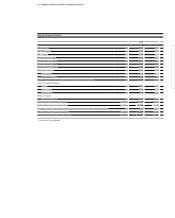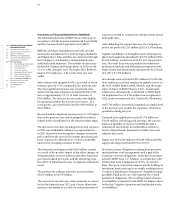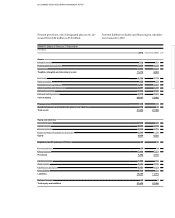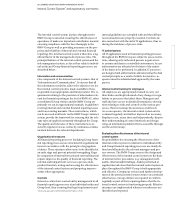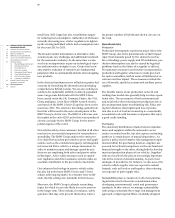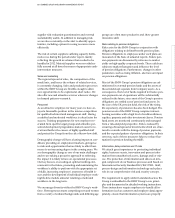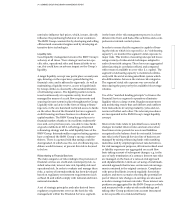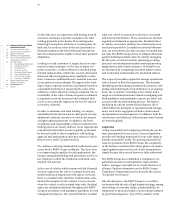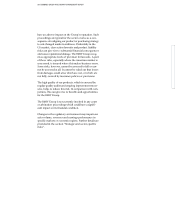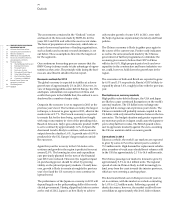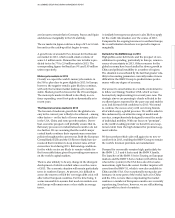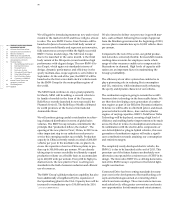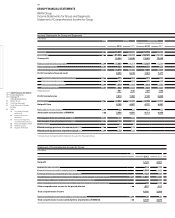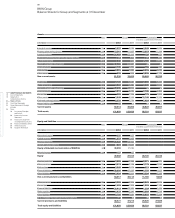BMW 2012 Annual Report Download - page 70
Download and view the complete annual report
Please find page 70 of the 2012 BMW annual report below. You can navigate through the pages in the report by either clicking on the pages listed below, or by using the keyword search tool below to find specific information within the annual report.
70
18 COMBINED GROUP AND COMPANY
MANAGEMENT REPORT
18 A Review of the Financial Year
21 General Economic Environment
24 Review of Operations
44 BMW Stock and Capital Market
47 Disclosures relevant for takeovers
and explanatory comments
50 Financial Analysis
50 Internal Management System
52 Earnings Performance
54 Financial Position
57 Net Assets Position
59 Subsequent Events Report
59 Value Added Statement
61 Key Performance Figures
62 Comments on BMW AG
65 Internal Control System and
explanatory comments
66 Risk Management
74 Outlook
used and that risks pertaining to information technol-
ogy (IT risks) are dealt with transparently. Regular com-
munication, awareness-raising activities and training
measures (e. g. online training on information and data
protection issues) create a high degree of security and
risk awareness among the employees involved. Employees
also receive training from the Group’s Compliance
Organisation to ensure compliance with legal and regu-
latory requirements.
Potential IT and data protection risks resulting from
the use of information technology and the processing
of information are monitored on a regular basis and
managed by the departments responsible.
The technical data protection procedures used primarily
involve process-specific security measures. Standard
activities such as virus scanners, firewall systems, access
controls at both operating system and application level,
internal testing procedures and the regular backing up
of data are also employed. A security network is in place
group-wide to ensure that stipulated requirements are
complied with. A high level of protection is afforded
by
regular analyses, detailed up-front controls (such as
compliance with mandatory data protection require-
ments) and rigorous security management (for instance
in the form of our centralised Security Operation Cen-
tre, which is responsible for monitoring internal net-
work traffic). The IT data protection and security strategy
adopted in 2011 has not only tightened security within
the BMW Group, it also helps to identify IT risks and
enables appropriate action to be taken. At the same time,
the Group’s data protection strategy was adopted and
a set of data protection rules published, which apply for
all of the Group’s employees.
In the case of cooperation arrangements and business
partner relationships we protect our intellectual property
as well as customer and employee data by stipulating
clear instructions with regard to data protection and the
use of information technology. Information underlying
key areas of expertise is subject to particularly stringent
security measures.
Financial risks and those relating to the provision of
financial services
Currency risks
The sale of vehicles outside the eurozone gives rise
to exchange risks. The BMW Group’s currency risk in
2012 was dominated by the US dollar, the Chinese
renminbi, the British pound, the Russian rouble and
the Japanese yen. Foreign currency risks are determined
for forecast exposures measured using cash flow-at-
risk models and scenario analyses. Operational currency
management is based on the results provided by these
tools.
The BMW Group manages currency risks both at a
stra-
tegic (medium and long term) and at an operating
level
(short and medium term). In the medium and long
term, foreign exchange risks are managed by “natural
hedging”, in other words by increasing the volume of
purchases denominated in foreign currency or increas-
ing the volume of local production. In this context,
the expansion of the plant in Spartanburg, USA, and
the opening of the BMW Brilliance joint venture’s new
plant in Tiexi in 2012 at the Shenyang site, China, are
helping to reduce foreign exchange risks in two major
sales markets.
For operating purposes (short and medium term),
cur-
rency risks are hedged on the financial markets.
Hedging transactions are entered into only with finan-
cial partners of good credit standing. A description of
the methods applied for risk measurement and hedging
is provided in the notes to the Group Financial State-
ments. Counterparty risk management procedures are
carried out continuously to monitor the creditworthi-
ness of business partners.
Raw material risks
The availability of specific groups of raw materials and
changes in raw materials prices both represent signifi-
cant risks for the BMW Group. In order to safeguard
the supply of production materials and reduce cost
risks, commodities markets are closely monitored and
analysed.
Financial derivatives are employed to hedge against
price risks arising for precious metals (i. e. platinum,
palladium and rhodium) and non-ferrous metals (i. e.
aluminium, copper and lead) and, to some extent,
steel and steel ingredients such as iron ore. Medium
and long-term purchase contracts with fixed pricing
arrangements for raw materials such as steel and plas-
tics are also in place. A description of the methods
applied for risk measurement and hedging is provided
in the notes to the Group Financial Statements.
Changes in the price of crude oil (as a basic ingredient
in many of our components) have an indirect impact on
our production costs. Crude oil prices (and exchange



